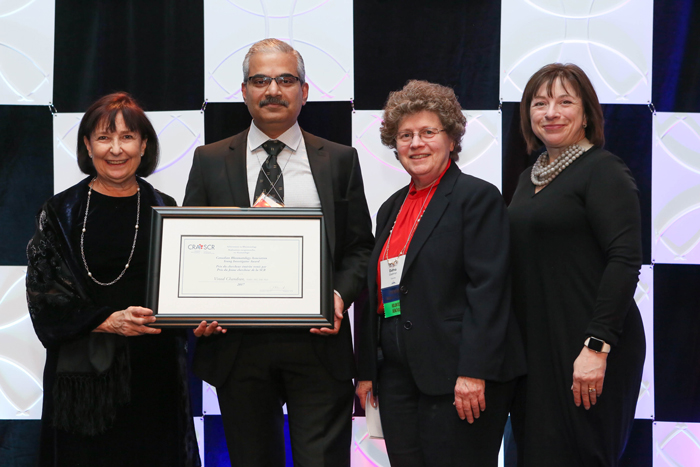Summer 2017 (Volume 27, Number 2)
Young Investigator:
Dr. Vinod Chandran
Download PDF
What compelled/inspired you to become a rheumatologist and a clinician-scientist?
I completed my clinical immunology-rheumatology training in the early 2000s in India. At that time, rheumatology was an emerging specialty. It was seen as a natural subspecialty to train in for those inclined to undertake advanced training in internal medicine, and the management of complex and sometimes obscure systemic diseases. I therefore applied and was accepted to the only centre in India offering such training.
The training at the Sanjay Gandhi Institute of Medical Sciences, Lucknow, was structured to allow time for thoughtful reflection on cases encountered, translational research, and close collaboration with basic scientists and PhD students in immunology. We learned basic immunology from the immunologists and they learned clinical relevance of their research from us. We also had to spend a year in the laboratory doing bench research. This set the stage for me to become a translational researcher. My subsequent fellowship and PhD training at the University of Toronto set me up on the path of becoming an independent clinician-scientist in translational research in my chosen field of spondyloarthritis and related diseases.
What was your first thought when you learned that you would receive this award?
Clerical error!; Better wait for a few days before I let other people know…
One aspect of your current research is focused on developing a soluble biomarker-based screening and prognostic tools for psoriatic arthritis, a potentially debilitating inflammatory arthritis. What would be the clinical implications of your research? How could it change the way a diagnosis is perceived?
There is considerable subjectivity in the diagnosis and assessment of the spondyloarthrides, including psoriatic arthritis. It is often uncertain if the patient seen in the clinic has the disease, or if the disease is active requiring escalation of therapy. I believe that valid and reliable biomarkers will help the clinician be more confident in the diagnosis and assessment of psoriatic arthritis and thus lead to better care of patients with this heterogeneous disease.
What has been your proudest accomplishment in your research to date?
Identification of putative soluble biomarkers through proteomic analyses of synovial fluid and skin biopsies from patients with psoriatic disease.
You’ve published 144 journal articles, 2 books and 7 book chapters and achieved an H-index of 32–your work on genetics, classification criteria and soluble biomarkers being the most cited. How has your research influenced the international and Canadian research landscape within rheumatology?
It is still early days yet, but my current research has opened up new avenues for biomarker discovery, and complements genomic, transcriptomic and metabolomic studies in psoriatic disease. Simultaneously, my research has also identified possible new drug targets, better methods of assessment of disease and treatment, barriers for referral and diagnosis of psoriatic arthritis, and will eventually lead to better outcomes for patients with psoriatic disease.
You are handed a plane ticket to anywhere? Where do you go?
One ticket will not do – I need two – and we will fly off to Bhutan, the land of the thunder dragon, the last Shangri-la…
If you had an extra hour in the day, how would you spend it?
Reading non-fiction.
What would your advice be to a student considering the possibility of pursuing research into rheumatic diseases?
Rheumatic diseases are common and have a significant adverse impact on a large proportion of people in Canada and across the globe. There are a number of unmet needs when caring for patients with rheumatic diseases. If one is passionate about making a difference for a large number of people, tremendous opportunities in doing so exist because of the recent progress in technology and scientific methods. Ultimately, rheumatic disease research will be extremely satisfying.
What are some of the highlights and challenges you have experienced thus far in your career? How have you overcome these challenges?
The Siminovitch-Salter award for my PhD thesis and the CRA Young Investigator awards have been the highlights of my training and career thus far. My challenge has been to find my own independent path in the current intensely competitive environment. Having a mentor, as well as identifying unique research avenues through networking and collaborations beyond my core fields of rheumatology, immunology and genetics will help me overcome my current challenges.
What do you most love about living in Toronto?
I love the anonymity that living in a large bustling city provides to an introvert like me. The ability to experience the diversity of the human form and spirit within a few square kilometres is fascinating!
Vinod Chandran, MB, BS, MD, DM, PhD
Assistant Professor of Medicine,
Division of Rheumatology,
Department of Medicine
University of Toronto
Staff Physician,
University Health Network
Mount Sinai Hospital
Toronto, Ontario

Dr. Chandran receiving his award from Dr. Heather McDonald-Blumer, Dr. Dafna Gladman, and Dr. Joanne Homik
|
